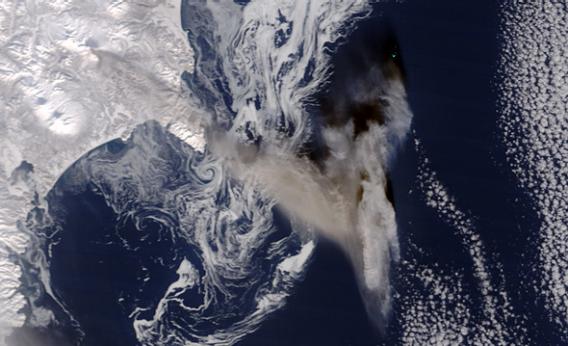Create a free profile to get unlimited access to exclusive videos, sweepstakes, and more!
Earth, Wind, Fire, and Water

How can I possibly not write about four of my favorite things all in one place: 1) satellite imagery of our lovely planet, 2) volcanoes, 3) cloud patterns, and 4) gorgeous swirly ice patterns?
All four of these are exemplified in the natural-color image above, taken by the Terra satellite (ding!) on Feb. 13. While it was over northeastern Asia—specifically the Kamchatka Peninsula—it caught the ashy plume of the volcano Zhupanovsky (ding ding!), which has been active for the past few years after decades of silence. It blasted ash 10,000 meters into the air, prompting aircraft warnings (ash is made of tiny glassy grains that are wickedly sharp and can foul engines and abrade windshields).
You can see the plume extending to the lower right (southeast) in the image, then rather abruptly stopping and piling up. Just past that is a layer of puffy clouds (ding ding ding!), which look to my eye to be altocumulus floccus, puffy medium-size clouds that form where rising warm air mixes with colder air. These can be near weather fronts, which may also explain why the plume stops right before them; there’s an air mass blocking the way. Altocumulus usually forms lower than 6,000 meters, though, putting them lower than the plume, so I might be guessing incorrectly here. Still, it seems clear there’s some connection given the way the plume stops.
Decorating this scene, too, are phenomenal patterns of sea ice, swirling around as they follow the currents offshore (ding ding ding ding!). From the ocean surface that would be a forbidding sight, I’d wager, but from a few hundred kilometers straight up what you get is fantastic art.
Which is no surprise to me. Satellite imagery of such things is frequently brain-stunningly beautiful. And that’s just a bonus to the important and amazing science we learn from them, too. Studying our planet from space is a win all around.
I found this image, as I usually do, on NASA’s Earth Observatory Image of the Day, one of my seriously all-time favorite sites on the Web. Go there, hit the archives, and breathe in the beauty of our planet.


























